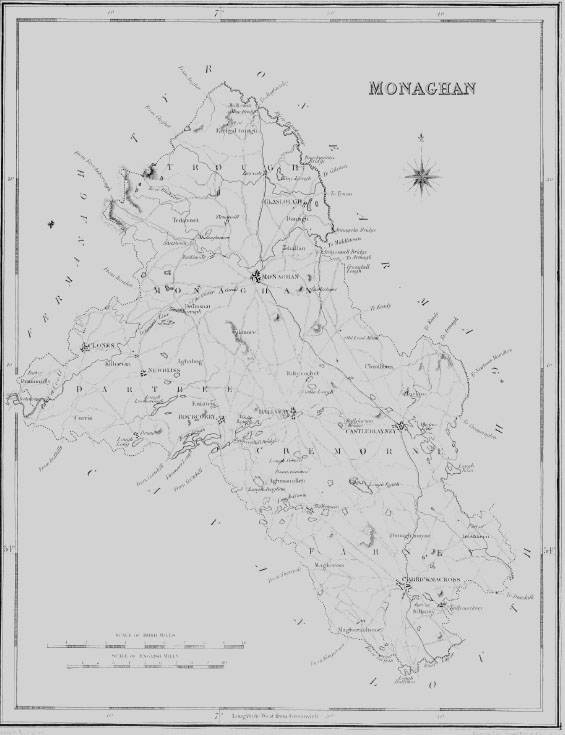| Accompanying Lewis map for Monaghan 
|
| CASTLE-BLAYNEY |
| CASTLE-BLAYNEY, a market and post-town, in the parish of MUCKNOE, barony of CREMORNE, county of MONAGHAN, and province of ULSTER, 11 miles (S. E. by E.) from Monaghan, and 49 (N. N. W.) from Dublin; containing 1828 inhabitants. It derives its name and origin from Sir Edward Blayney, governor of the county of Monaghan in the reign of Jas. I., who, in consideration of the dependence of his garrison at Monaghan and Newry for a supply of provisions, which was rendered precarious by the hostility of the intervening country, received a grant of two ballybetaghs of land here) on condition of his erecting a fort between Monaghan and Newry; Castle-Blayney was accordingly erected, as a secure halting-place for the royal troops, and Sir Edward received this extensive estate, which his descendants still enjoy. The collection of habitations formed in the vicinity never, however, assumed the appearance of a town until the establishment of the linen market, and the rebuilding of the houses with stone, in the latter part of the last century, by the late noble proprietor. It is situated on the mail coach road from Dublin to Londonderry, and comprises 341 houses; is lighted by subscription, and has a respectable appearance. It consists of three streets meeting in the market-place, which is of a triangular form; and in the centre, on an elevated spot commanding every avenue, is the market-house, a very neat and ornamental building, with a spacious room on the second story, and a neat bell turret above the roof. Near the market-house are convenient shambles. The manufacture of linen, though not so extensive as formerly, furnishes employment to many persons in the surrounding districts; and there are three tanyards in the town. The rincipal market is on Wednesday, when considerable quantities of yarn and flax are sold: there are also markets for corn and butter on Tuesday and Friday; and fairs for live stock are held on the first Wednesday in every month. Here is a constabulary police station; also a neat sessions'-house, in which the quarter sessions for the county are held four times in the year, and petty sessions every alternate week and a county bridewell, which affords the necessary accommodation for the classification of prisoners. The mansion of Castle Blayney, the seat of Lord Blayney, is closely adjoining, and is encompassed by a demesne of great extent and beauty, which includes the Lake of Mucknoe and some fine woodland scenery: it is a handsome modern edifice, built near the site of the old castle. The ruins of an ancient fortress in Cornero wood, on the shore of the lake, are also within the demesne. The parish church of Mucknoe is in the town; it is very neat, with a handsome spire, and the interior has been comfortably fitted up by Lord Blayney, who has also planted the churchyard with trees and evergreens. There are also places of worship for Roman Catholics, Presbyterians, and Wesleyan Methodists. The parochial school, situated here, has an average attendance of 35 children; and there is a school for girls, supported by Lady Blayney, with an average attendance of 70 children. Here is also a fever hospital. -See CLONTIBRET and MUCKNOE. |
| MUCKNOE |
| MUCKNOE, a parish, in the barony of CREMORNE, county of MONAGHAN and province of ULSTER, on the road from Carrickmacross to Armagh ; containing, with the post-town of Castle-Blayney (which is separately described), 9717 inhabitants, This parish comprises 17,194 statute acres, according to the Ordnance survey, of which 14,155 are applotted under the tithe act, 377- are in Mucknoe lake, and 163 in smaller lakes ; the land consists chiefly of arable and pasture, but there are large detached tracts of bog, and a considerable portion is mountain, of which Mullyash rises 1034 feet above the level of the sea. The principal crops are oats, flax, and potatoes: stone quarries are worked for building ; and there are two cornmills. Monthly fairs are held at Castle-Blayney. Castle-Blayney, the seat of Lord Blayney, is noticed under the head of that town. The living is a rectory and vicarage, in the diocese of Clogher, and in the patronage of the Bishop ; the tithes amount to £436. 3. 1. The glebe-house was erected in 1828, at an expense of £1027, of which £184 was a gift and £553 a loan from the late Board of First Fruits ; the glebe comprises 20 acres, valued at £39 per annum, The church stands in Castle-Blayney: it was erected in 1810 by a loan of £1000 from the same Board, and gifts of £200 from the late Lord Blayney, £100 from Lord Templeton, and £50 from Lady Eliz. Alexander, In the R. C. divisions the parish is partly in the union of Clontibret, and partly a benefice in itself; it has two chapels, one at Oram, and the other in Castle-Blayney, which is a neat building. There are four places of worship for Presbyterians ; one in connection with the Synod of Ulster, of the second class ; two at Frankfort and Garmoney Grove, in connection with the Seceding Synod, the latter of the second class ; and one belonging to the Scotch Covenanters. There is also a meeting-house for Wesleyan Methodists. About 700 children are educated in 11 public schools, of which the parochial school is aided by the incumbent ; and a female school is supported by Lady Blayney ; and in 11 private schools are about 540 children. |
|